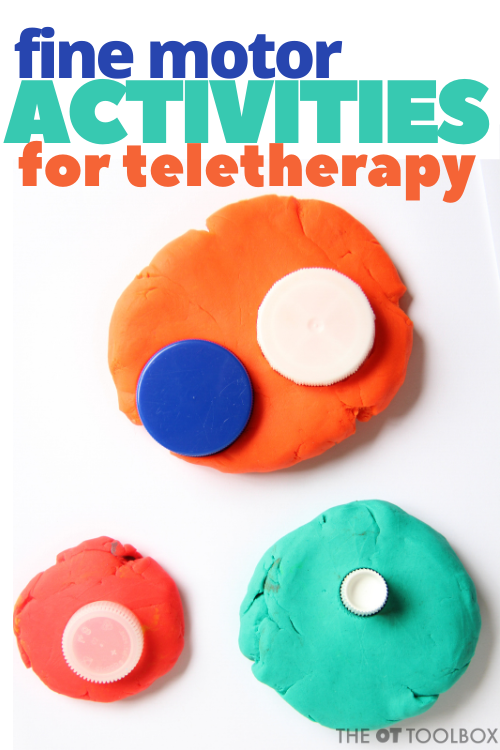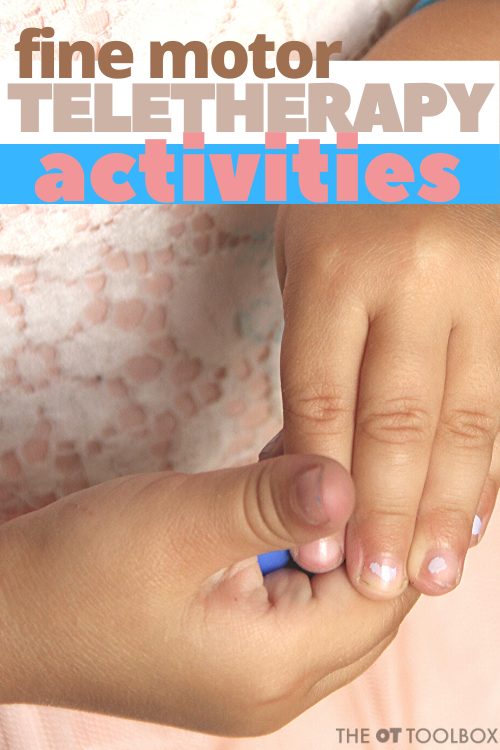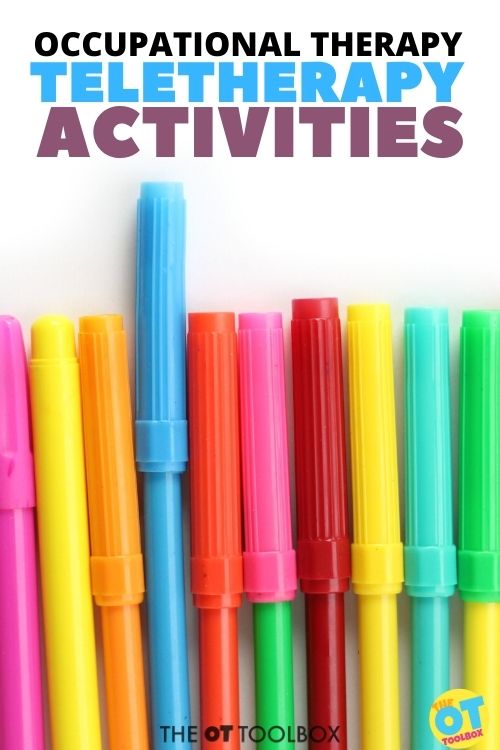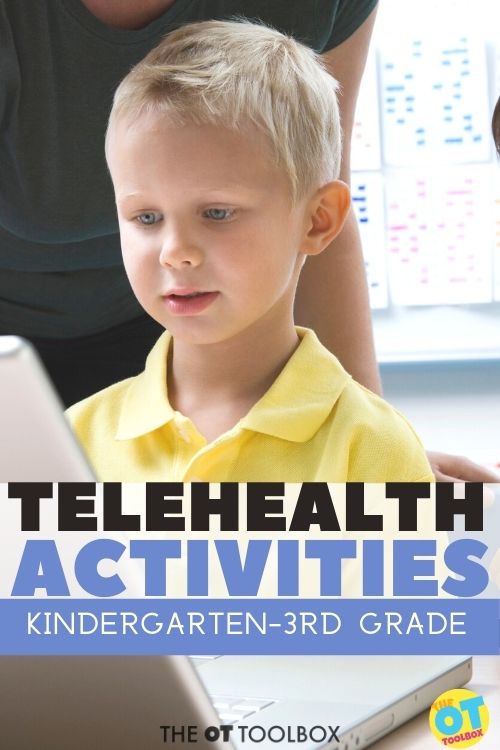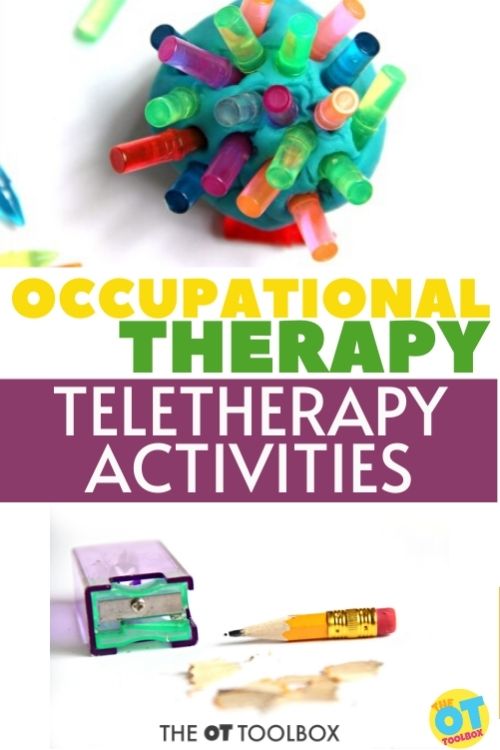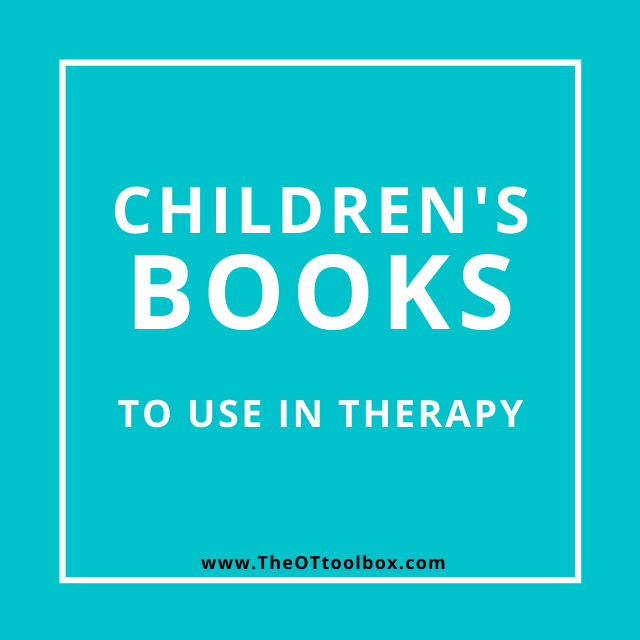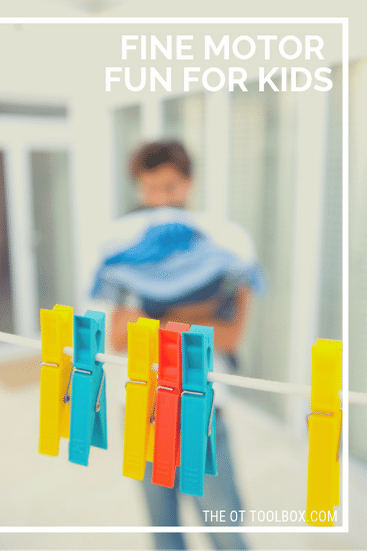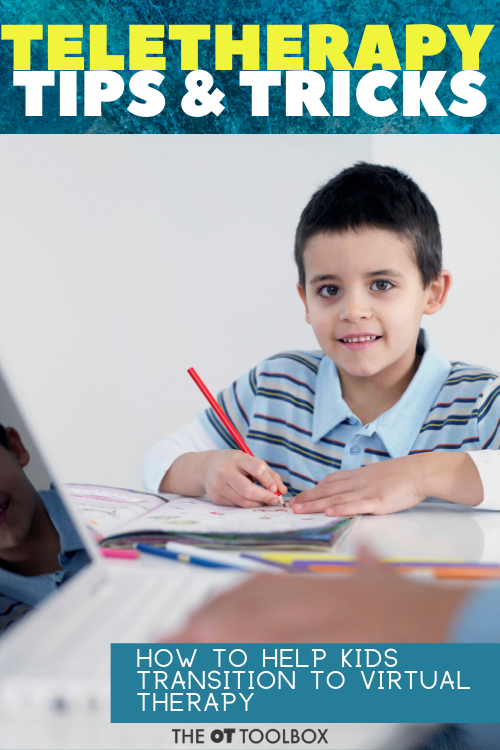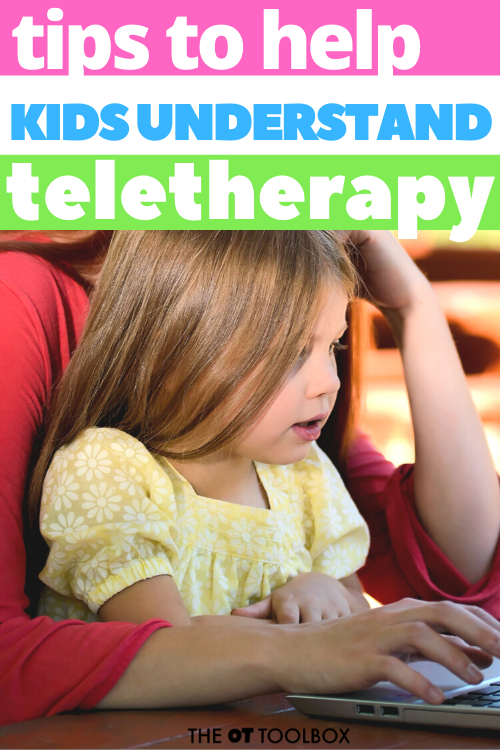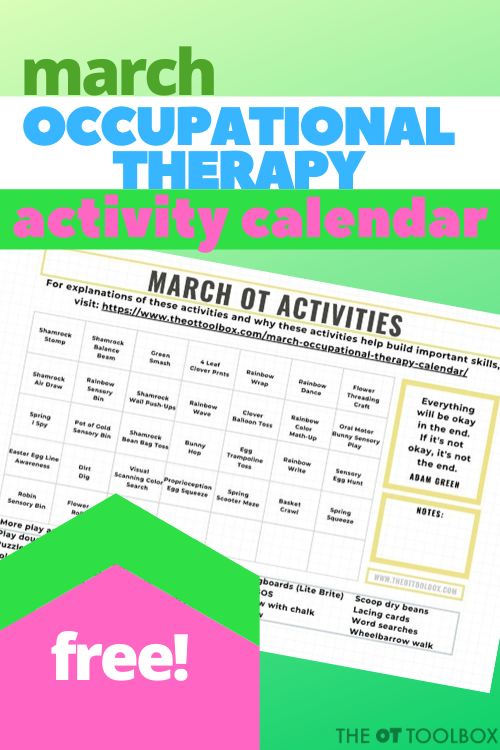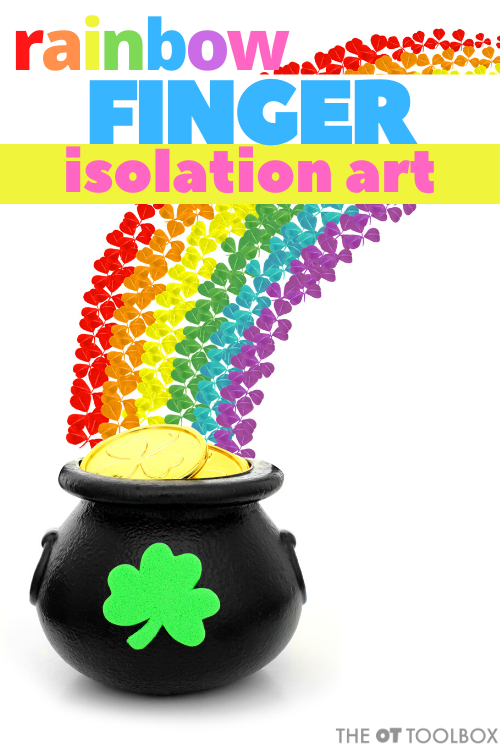In this article on teletherapy activity ideas for kids, you will learn how to enhance a variety of skills through basic, fun activities. OT is online more than ever in recent days and therapy services may be scrambling to identify occupational therapy activities that can serve children and families in the OT telehealth format. Children and therapists may both be familiar with some of these teletherapy activities, whereas others may be learning experiences for the entire family unit.
We will provide some teletherapy activities broken down by age range so that therapists can best enable functional performance and occupational engagement in the children they serve. To better understand teletherapy start with out recent post that explains the online therapy service.
How to plan occupational therapy teletherapy sessions
One of the hardest parts of OT telehealth can be the planning. Week after week, it is difficult to come up with occupational therapy activities that meet the needs of your clients.
Over the past year, I’ve created many free slide decks that help alleviate some of the stress of consistently creating new therapy activities for digital services. These Google slide decks are completely free and can be used to meet a variety of needs and ages in OT services. Pair the slide decks with weekly occupational therapy themed activities for a combination of hands-on activities and digital resources.
Using the slide decks makes therapy planning easier because you can make a copy for each client and modify the slides to meet the specific goals and needs for each individual on your caseload.
Then, add in some of the age-specific activities listed below.
Teletherapy Activities for Early Intervention
Let’s start with teletherapy for birth to three. Many therapists may struggle with understanding how early intervention services (also known as EI, or “birth to three”) can be provided virtually. The truth is, there is not much difference between teletherapy EI and standard EI programming, since both services are provided within the home and each place a heavy focus on family education.
Early intervention therapists can provide training, health information, and in-home strategies to assist with the care of children who demonstrate developmental delays, medical, concerns, or behavioral issues.
Intervention at the early intervention stage can involve a lot of parent coaching. You can address parent concerns regarding child development, addressing difficult behaviors, occupations for the client and family as a support. Parent education can involve occupations of self-care, feeding, sleep, anxiety or worries, attention, executive functioning skills, or any aspect of occupational performance that comes up within the home.
Therapists should ideally provide education that is unique to the child (and their family unit) covering topics such as positioning (for sleep, car seats, and play time), ways to enhance fine motor development and gross motor development, facilitating participation in self-care tasks, productive play, and more. Here are ways to work on fine motor skills in teletherapy.
In this way, the majority of the content that therapists provide families with will mimic traditional home training or home exercise programs (HEPs) that are provided as part of EI treatment.
Therapists in this setting can also provide children with exercises in some of the following areas, depending on their specific concern(s):
- Shape and object identification games
- Letter and number tracing
- Counting, sorting, and early comparing activities with animals, superheros, cartoons, shapes, etc.
- Pattern recognition activities
- Simple digital jigsaw puzzles
- Online games and apps
- Bingo activities with numbers, letters, and shapes
- Holiday-themed activities involving drawing shapes and forming them into objects
- Counting coins, playing shopping/store-related games
- Target games involving planning/aiming, throwing, and picking up
- Gross motor obstacle courses or chalk sensory walks
Here are some quick activity ideas that lend themselves nicely to teletherapy in early intervention:
Backhoe Shapes Craft
Easy Shapes Salt Truck Craft
Preschool Activities
Teach Nose Blowing
Pre-Writing Lines Activities
Teletherapy Activities for Kindergarten-3rd Grade
Next, let’s talk teletherapy activities for Kindergarten through third grade. Children between the ages of 5 and 9 can also benefit from teletherapy activities to build and strengthen skills related to sensory regulation, behavior management, handwriting, self-care, and effective communication.
Teletherapy activities for kindergarten through 3rd grade can focus on addressing these concerns may include some of the following:
- Digital coloring pages
- “Find the differences” exercise involving comparisons between two similar images
- Object matching games
- Handwriting exercises
- Interactive versions of basic games such as Connect Four, tic-tac-toe,
- Cause-and-effect games to encourage early understanding of problem solving and right vs. wrong
- Worksheets prompting sequencing for basic activities (going to the movies, eating dinner, etc.)
- Basic human body educational activities (coloring pages, identification charts, and functional purpose)
- Education on “How does your engine run?” levels to assist in regulating emotions
- Traditional draw and cut activities
- Theraband and theragrip for basic strengthening
- Gross motor obstacle courses or sensory walks
Here are more quick OT telehealth ideas for primary grades:
Therapy Band Exercise Program
Zones of Regulation Activities
Kids Crafts for Occupational Therapy
Motivating Handwriting Activities
Indoor Balance Beams
TELeTherapy Activities for Grades 4-8
Occupational therapy telehealth for older grades can expand into further topics. While many of the K-3 activities can be modified for some older children, there are multiple teletherapy activities that can be used for children in this age range. Teletherapy activities for these children may focus on topics such as communication, behavior management, relationships, rule-following, self-care skills, and more.
Try some of these ideas in planning online therapy services for grades 4th through 8th grade:
- Word searches, jumbles, or crosswords
- Mazes
- More complex jigsaw puzzles and strategy-based games
- Story-based cause-and-effect activities
- Creative writing prompts to explore emotions
- Role identification
- Sports-based games and exploration of hobbies
Here are a few quick activity ideas for teletherapy in the older grades:
Games to Work on Executive Functioning Skills
Organization Activities and Strategies
Cursive Activities
Areas That Therapists May Struggle to Address
There are certain areas that teletherapists may struggle to incorporate into teletherapy activities. The good news is, with a little creativity, therapists can ensure that the children they treat are receiving the well-rounded treatment they need to advance their skills in a range of areas.
Force modulation: Some games require the use of a tablet and stylus, which allows children to practice force modulation that cannot be addressed by typical point-and-click activities. Therapists can also encourage the use of alternative activities covering force modulation, such as clapping or hi-fives (if another person is present in the room). Therapists might provide prompts such as, “If it’s loud enough for me to hear – you are doing okay! If it makes your hand turn red and hurt – you are hitting too hard! If the two hands are barely touching – you aren’t hitting hard enough!”
Sensory regulation: This is best addressed when you have an e-helper present to aid during the session. However, with some simple planning ahead from a parent or teacher’s assistant, therapists can make sure their kiddo has the materials needed to work on this skill during the session. These e-helpers can provide children with a variety of sensory input (per therapist recommendation and supervision) including soothing music or nature sounds, various textured fabrics, weighted blankets, essential oils, brushing protocols, visually soothing colors, and much more.
Other strategies, such as brushing protocols, can even be trialed or implemented with children per therapist demonstration and instruction. All of this is, of course, best supplemented by educating parents, teachers, and other loved ones on the use of a sensory diet to maximize a child’s tolerance and regulation of sensory input.
If you are searching for additional resources to serve as inspiration or reference for teletherapy activities, check out some of the following websites:
OT Teletherapy ACTIVITIES by area
Children’s books activities
Need an idea to keep the kiddos busy AND building skills like fine motor work or executive functioning? Need an activity for teletherapy sessions that cover a variety of areas like scissor skills, bilateral coordination, eye-hand coordination, and more?
Grab one of these popular children’s books and activities (OR find a reading of them online) and then make the craft or activity outlined on The OT Toolbox
Have fun exploring books through play!
Handwriting activities for teletherapy
Ohhh, it’s tricky to get the kids to do the hard things in the place they feel safe and loved. Handwriting work they may have had in the classrooms might be a foot stomping “NO!” In the dining room classroom! Here are ways to make handwriting fun:
Easy handwriting activities can be sent as home programs or used in virtual OT sessions via a screen.
These irresistible handwriting activities can work for kids who hate to write.
Natural writing experiences (it’s not about the writing…or is it??? ??) can make handwriting practice at home fu,.
Use these handwriting tips & tricks in fun ways as part of home programs.
Many therapists and medical providers have moved to virtual telehealth services recently. Many more will transition to this type of service delivery next week. Here are teletherapy resources to better help understand and deliver virtual therapy:
Understanding teletherapy to get a better vision of what teletherapy actually looks like in action.
Additionally, diving into various Occupational therapy teletherapy platforms can be helpful to know where to begin.
Sensory Diet activities for home programs
“A sensory diet is a group of activities that are specifically scheduled into a child’s day to assist with attention, arousal and adaptive responses. The activities are chosen for that child’s needs based on sensory integration theory. … These activities are designed to produce a positive effect on a child.” Here are sensory diet tools I’ve got on the website. Use them in parent education and conferencing or as recommended reading.
Part of virtual teletherapy sessions can involve parent education and explaining the specific Goals of a sensory diet.
These backyard slide and swing activities can be done at home using Sensory diet activities in backyard playground equipment.
Fine Motor Activities in telehealth
I’ve had a few requests for this fine Motor Activities using items commonly found in the home.
These fine motor activities and exercises with parents needing tools to build strength and dexterity. Or, use these ideas in teletherapy services:
Playing cards
Craft Pom poms/cotton balls
Paper clips
Play dough
More regular home item activity lists coming. These are completed but on the backlog in getting them up on the site.
Cooking Activities for virtual therapy
Need some ways to build skills, inspire learning, connect with the kiddos, AND take a minute to reflect on everything? Use that kitchen! Cooking with kids is a great way to build many sill areas.
Cooking is such a great way to build motor skills, sensory experiences, build self-confidence, open up opportunities for conversation, work on math concepts, executive functioning…there are so many areas of learning and growth in cooking tasks.
Here are some resources on kid-friendly recipes that can be graded to make them easier or more difficult for younger/older kids:
These kid-friendly recipes build skills. Send them as home programs or make them along with the child and an E-helper.
You can teach direction-following with cooking with these recipes.
Cooking builds motor skills. Use these recipes and simulated cooking activities (GREAT for virtual therapy sessions!) while building motor skills.
Brain breaks in OT teletherapy
? Brain Breaks! ?
These themed activities are quick wins, and (many times) the re-set button that we can all use at one time or another. Brain breaks can be movement-based actions, whole-body breathing strategies, or just a mental reprise. These are perfect ?? for an afternoon re-set or during schooling at home activities.
Themes and brain break activities galore can be found here.
Use crafts in OT teletherapy
Crafts that build skills
Need a craft or two that doubles as a tool to build fine motor skills, eye-hand coordination, scissor skills, bilateral coordination, midline crossing, hand strength, tactile exploration, and more?
Here are TONS of kids craft ideas to get you started (therapist-approved!)
Executive Function activities in teletherapy
Ok…with schooling at home, managing the laundry pile, working with kids playing under the table, trying to get them to read a real, live book…are you running into trouble with prioritization, planning, impulse control, working memory, organization? ? All of these skills are executive functioning! Impulse control, prioritization, planning, working memory…executive functioning skills can be worked on at home. Here are activities, along with information on how and why these areas impact functioning.
What are EF skills
Attention
Games to improve EF
Working memory
Ok…the kids are on screens A TON now, right? Here are creative ways to build motor skills, motor planning, and coordination using everyday, household items that you probably have in the home right now. Add these to your teletherapy line-up for hands-on activities that don’t involve apps, videos, or computer slides:
Pencil control exercises with paper and pencil– Use just a pencil and paper to work on pencil control, hand strength, and visual motor skills. We used colored pencils, but this activities works with a regular pencil, too. Practice shading in the circles with more or less pencil pressure to work on proprioception.
Grasp development and in-hand manipulation with recycled containers– Use recycled water bottles, plastic containers with lids, and other upcycled items to work on grasp strength, and translation to remove caps and lids. Washing out the containers is a GREAT functional task, too. Then, kids can throw the recycled containers right into the recycle bin when they are finished with this activity.
DIY tongs with craft sticks/pencils– One of our oldest posts here on the website, you can use craft sticks and craft pom poms OR, if those items are available in the home, no problem. Substitute them for a pair of pencils and rolled up pieces of paper to make DIY tongs.
Balance beam ideas using household items– Kids can work on coordination, motor planning, balance, and core strength in the home using regular, household items in DIY indoor balance beams.
Intrinsic hand strength/motor planning, coordination with an egg carton & straw– Use what you’ve got! An empty egg carton, and pieces of straws, (or any other small item) can be a powerful way to work on hand stregth and intrinsic strength needed for pencil grasp and fine motor dexterity.
Fine motor with playing cards– Playing with items found in the home can build big skills in a low-tech manner. Playing cards can be used to build visual motor skills, visual perception, fine, motor and more.
Extended wrist/fine motor/eye-hand coordination with a
Colander & toothpicks- Head to the kitchen for this fine motor activity that builds big motor skills and coordination.
HELP KIDS UNDERSTAND TELETHERAPY
Amazon affiliate links are included below.
With the rise of telemedicine, the concept of teletherapy may be difficult for some children to grasp, especially those living with disabilities and those who are accustomed to traditional school-based therapy or outpatient rehab. Thankfully, there are resources available to guide children through this process and learn skills that make them stronger and more confident.
Why is there a person in my computer? is a child’s guide to understanding what teletherapy is and how it can help with a variety of medical concerns. This story follows Andrew, a child with visual deficits who is having difficulty playing hockey, performing well in school, and working on his art. He meets a therapist named Brittany who guides him through his first teletherapy session, and he loves it! This picture book helps children understand what teletherapy is, what makes it different from other therapies, and how it can help them live better lives. Children may also enjoy the supplemental activity guide complete with coloring pages, fact sheets, and more!
For more resources, be sure to join our Occupational therapy teletherapy mini course. You’ll receive resources and loads of information in this 5 day email course to guide OT teletherapy sessions and keep you on track to helping kids thrive in your teletherapy services.


